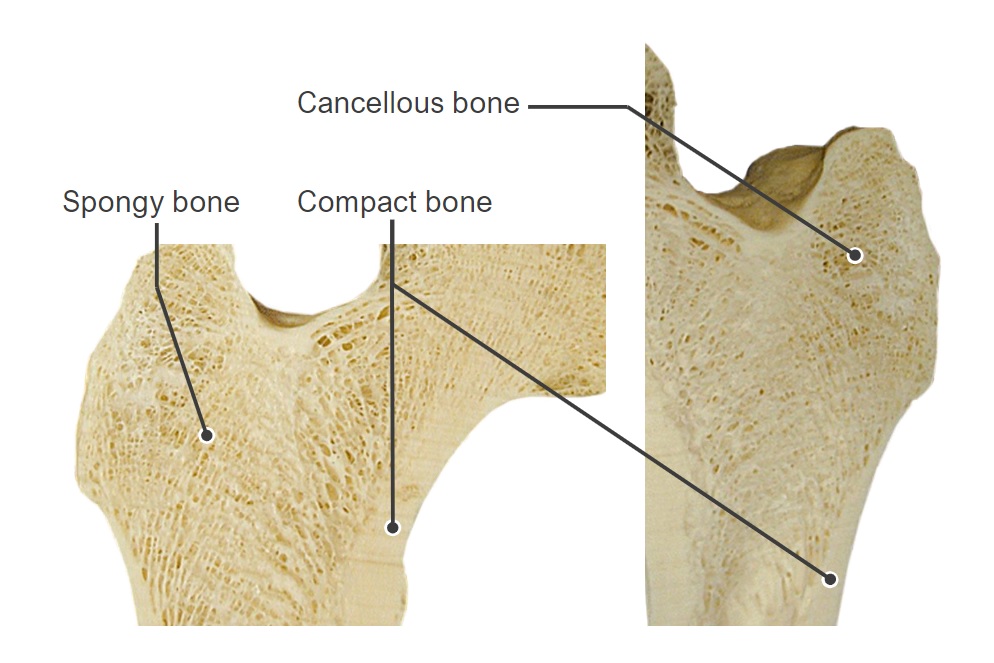Playlist
Show Playlist
Hide Playlist
Structure of Bones
-
Slides 08 Types of Tissues Meyer.pdf
-
Download Lecture Overview
00:02 In this lecture, I'm going to talk about bone. 00:05 But I'm going to concentrate on mature bone and the function of mature bone. 00:11 In a later lecture, I'm going to talk about bone formation and bone growth. 00:19 Bone is a very specialized connective tissue. 00:24 Like all connective tissues, it's composed of cells, fibers and matrix. 00:31 But in the case of bone, the matrix is calcified. 00:35 And because of that, it enabled bone to have some very important functions in the body. 00:43 It can protect vital organs of the body, the thoracic cavity protects the heart and the lungs. 00:51 The cranium protects the brain. 00:55 Bone always forms the skeletal components of the body, and in unison with muscle affects movement of the body. 01:07 It's also a very important mineral reserve for both calcium and phosphate. 01:14 And it provides a compartment for bone marrow to form blood cells. 01:20 I'm going to talk about these latter two functions in a lecture later on. 01:28 Let's look at really what I want you to understand with this initial lecture on bone. 01:37 First of all, I want you to appreciate that there are two types of bone, compact bone and spongy bone. 01:45 And I'll describe these two types during this lecture. 01:50 The very fundamental structural unit of bone is the osteon. 01:55 And I will also describe that, and it's something that you really should understand because it will explain to you really how bone forms its functional role in the body. 02:08 And equally important, you must understand how bone cells received their nutrients. 02:15 As I said earlier, the matrix is very hard, it's calcified. 02:20 Unlike other connective tissues, such as loose connective tissue or even cartilage. 02:27 There is no aqueous component of the extracellular matrix. 02:33 So nutrients, including oxygen, cannot diffuse through that matrix. 02:39 So I'm going to explain in this lecture how bone cells get their nutrients from the blood when they're embedded in this very firm calcified matrix. 02:51 So, again, let's look at what characterizes bone. 02:58 First of all, it's vascular. 03:00 Unlike cartilage, it has the blood supply. 03:03 It has a very large blood supply. 03:07 If you break a bone, it bleeds. 03:10 Again, like connective tissues, it has cells, fibers and matrix. 03:18 The cells are called osteocytes. 03:22 And these osteocytes live within the bone matrix. 03:27 And often you see just a small clear space, this is a lacuna. 03:34 And a lacuna is really, a space is occupied by the bone cell or the osteocyte. 03:43 Normally, the osteocyte would occupy the entire space. 03:47 But during processing of bone, often the cell is completely lost from its territorial area in the bone matrix, and just a small little space or lacuna remains. 04:01 Sometimes however, in some of these little lacuna spaces, you can see remnants of the osteocytes. 04:09 Again, like cartilage, the most important functional part of bone is the matrix.
About the Lecture
The lecture Structure of Bones by Geoffrey Meyer, PhD is from the course Bone Tissue.
Included Quiz Questions
What is the fundamental functional unit of bone?
- Osteon
- Osteophyte
- Osteocytes
- Haversian canal
- Chondrocyte
What type of tissue is bone?
- Connective
- Epithelial
- Muscular
- Nervous
- None of the choices provided is correct.
Customer reviews
5,0 of 5 stars
| 5 Stars |
|
4 |
| 4 Stars |
|
0 |
| 3 Stars |
|
0 |
| 2 Stars |
|
0 |
| 1 Star |
|
0 |
Super helpful introduction and outline of future lectures. I appreciate the integrated instructions surrounding structure, location, function, and particular roles within the body. These lectures are helpful supplements to textbook readings.
Simple, elegant, and easily gets to the point. Great lecturer.
it was clear and concise easy to understand key points layed out very well
Great lecture. It is very easy to follow. Great explanation.




